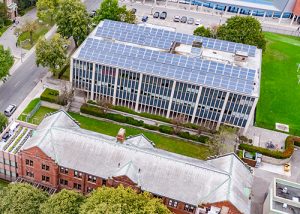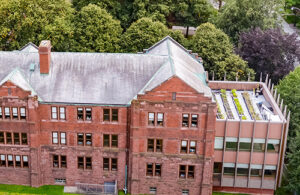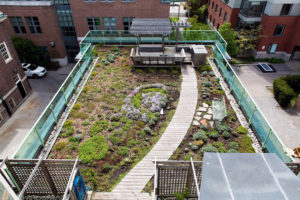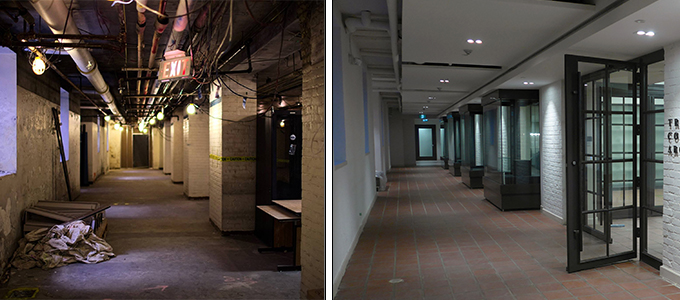Sustainable Practices
Other Sustainable Practices and Spaces on the Trinity College Campus
Trinity College is committed to sustainable practices and responsible stewardship of our campus. Below you will find some of Trinity’s ongoing initiatives:

Trinity College took an exciting leap toward becoming a leader in renewable energy with the installation of solar panels on the roof of the Larkin Building in 2010. The panels have helped the College reduce its greenhouse-gas emissions, and are among several other projects aimed at building on Trinity’s commitment to sustainability. Besides contributing to the production of greener energy, the solar panels offer an additional bonus: the sale of energy from the solar panels provides more than $25,000 each year in student financial aid.
By the Numbers
- 252: The number of solar photovoltaic (PV) panels installed on the roof
- 57: The kilowatt (Kw) strength of Trinity’s solar PV rooftop system
- 67,000: The number of Kilowatt hours per year (kwk) of energy the solar panels will produce
- 11: The number of racks in place to support the panels
- 45: The length, in feet, of each rack
2017 Update
We’re building a future for Trinity’s past!
As part of the renewal project, earlier this year, Trinity College installed a new geothermal system under the front lawn of the main building to provide environmentally-friendly heating and cooling to the new Archives (opened in 2017). This new system also provides stable temperature and humidity needed for the proper preservation of artifacts in the new Archives. In addition, the concrete blocks used in the new Archives are also environmentally sustainable (using repurposed waste carbon dioxide during the concrete manufacturing process). As part of the renewal project and to ensure accessibility to the new Archives (lower level of the main building), we installed a machine roomless elevator (MRL), which uses significantly less energy – 60% more energy efficient than an hydraulic elevator – and requires no oil, therefore no environmental risk and no oil odour. Reclaimed bricks were also used for the elevator construction.
- Learn more about the new Trinity Archives
- View photos of the transformation of the lower level to the new Trinity College Archives (2015 to 2017)
 An exciting new green project began in the summer of 2018 at Trinity. The urban agriculture container garden was created on the rooftop of one of Trinity’s buildings (North House of the Munk School). This new pilot project aims to not only reduce Trinity’s carbon footprint through the local production of food, but also to provide members of our community meaningful engagement with nature.
An exciting new green project began in the summer of 2018 at Trinity. The urban agriculture container garden was created on the rooftop of one of Trinity’s buildings (North House of the Munk School). This new pilot project aims to not only reduce Trinity’s carbon footprint through the local production of food, but also to provide members of our community meaningful engagement with nature.
 The roof garden at St. Hilda’s College is just one of many projects being researched and carried out by members of the Trinity Environmental Protection Committee and the Trinity College Environmental Society. Thanks to the financial support of the Class of 1958 and Trinity students (from student fee funds), the roof garden opened in the summer of 2008. The roof garden not only provides a leafy sanctuary for busy students and staff, but also act as insulation, cooling the building in the sweltering Toronto summers.
The roof garden at St. Hilda’s College is just one of many projects being researched and carried out by members of the Trinity Environmental Protection Committee and the Trinity College Environmental Society. Thanks to the financial support of the Class of 1958 and Trinity students (from student fee funds), the roof garden opened in the summer of 2008. The roof garden not only provides a leafy sanctuary for busy students and staff, but also act as insulation, cooling the building in the sweltering Toronto summers.
Trinity College continues to strive to reduce energy consumption in all its operations (steam, hydro and gas). Steam is used to heat the buildings, for cooking and for the supply of hot water; electricity (“hydro”) is used for lighting and for running machinery; natural gas is used for clothes dryers and cooking.
In March 2009, Trinity became the first university in eastern Canada to sign the University and College Presidents’ Climate Change Statement of Action, which commits the College to reducing greenhouse gas emissions and pursuing other solutions to climate change. The College now consumes about 25% to 30% less total energy than the average 10.4 million ekwh consumed annually before 2008. Within that total, hydro consumption is down significantly, to 1.8 million kwh in 2016-17, compared to more than 3 million kwh consumed in the early 2000s. Natural gas consumption is also way down because: domestic hot water is now being heated with steam rather than gas, which currently seems more efficient; and the consolidation of the dining halls in 2013 reduced steam used in cooking. We also installed a new geothermal system under the front lawn of the main building to provide environmentally-friendly heating and cooling to the new Archives (see below).The College will continue to pursue opportunities for further reductions in the future.
In the interest of resource preservation, in 2015, a 1,200 gallon cistern was buried in the front lawn of the main building for storm water reclamation. Rainwater from the roof will be captured and used to irrigate the front lawn, reducing Trinity’s demand for city water.
Trinity College hosts an urban beehive with two colonies on Henderson Tower. Helping to pollinate the trees and plants on Philosopher’s Walk, a small harvest of natural honey is obtained each fall. The hives are cared for by the student-run U of T BEES – learn more about Trinity’s bees (video).
From food service to procurement, water conservation, lighting retrofits, and waste management, Trinity College seeks to achieve best practices and break new ground in environmental activities. Here are a few more local actions for a sustainable campus:
- LED lighting and instantaneous hot water in the residence buildings for additional energy savings
- Renovations to the kitchen serving the Trinity’s Strachan Hall included a heat reclaim system to capture heat generated from cooking, and the introduction of tray-less dining to reduce waste.
- The heritage windows in Trinity’s residences have been sealed (Magnetic Window Seals) to help to stop drafts, greatly reducing heat loss in cold months (reducing energy use and costs) and increasing indoor comfort for residents. These retrofits are continuing in a phased approach
